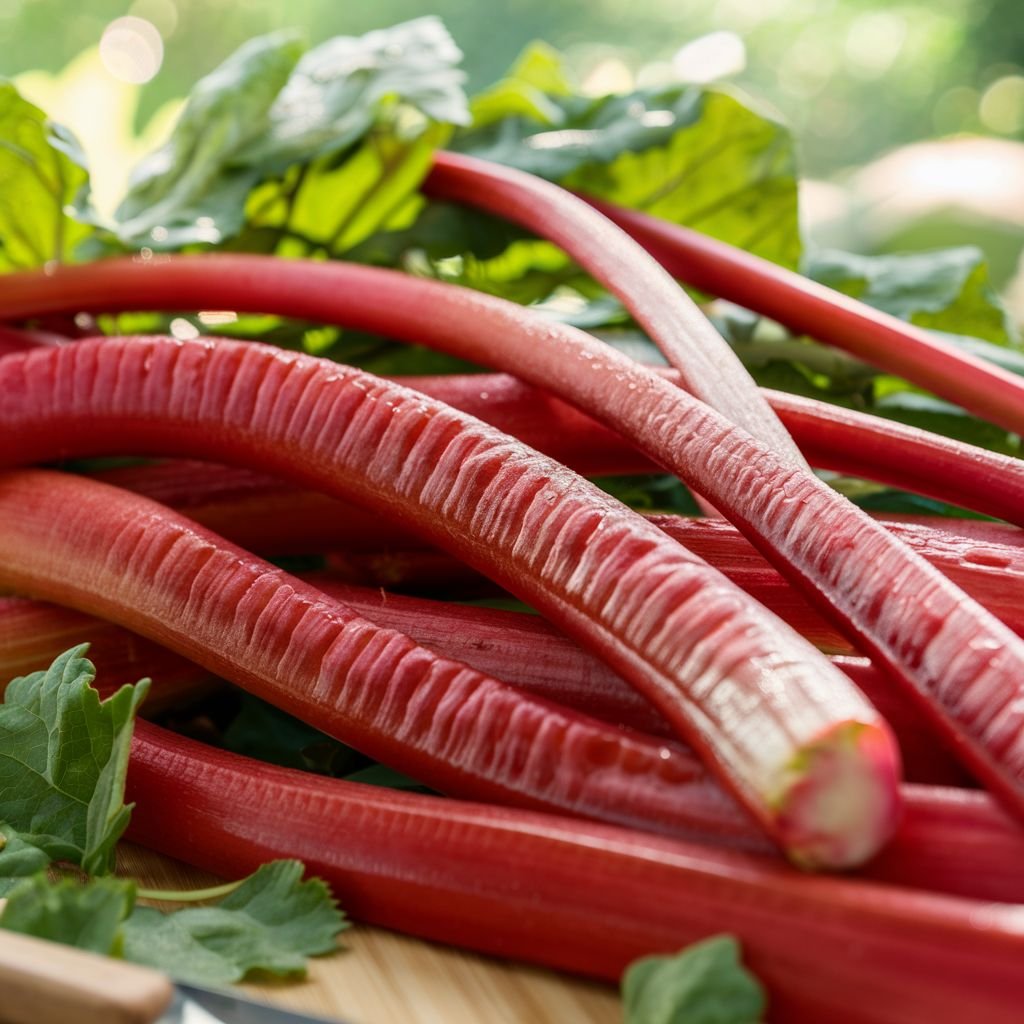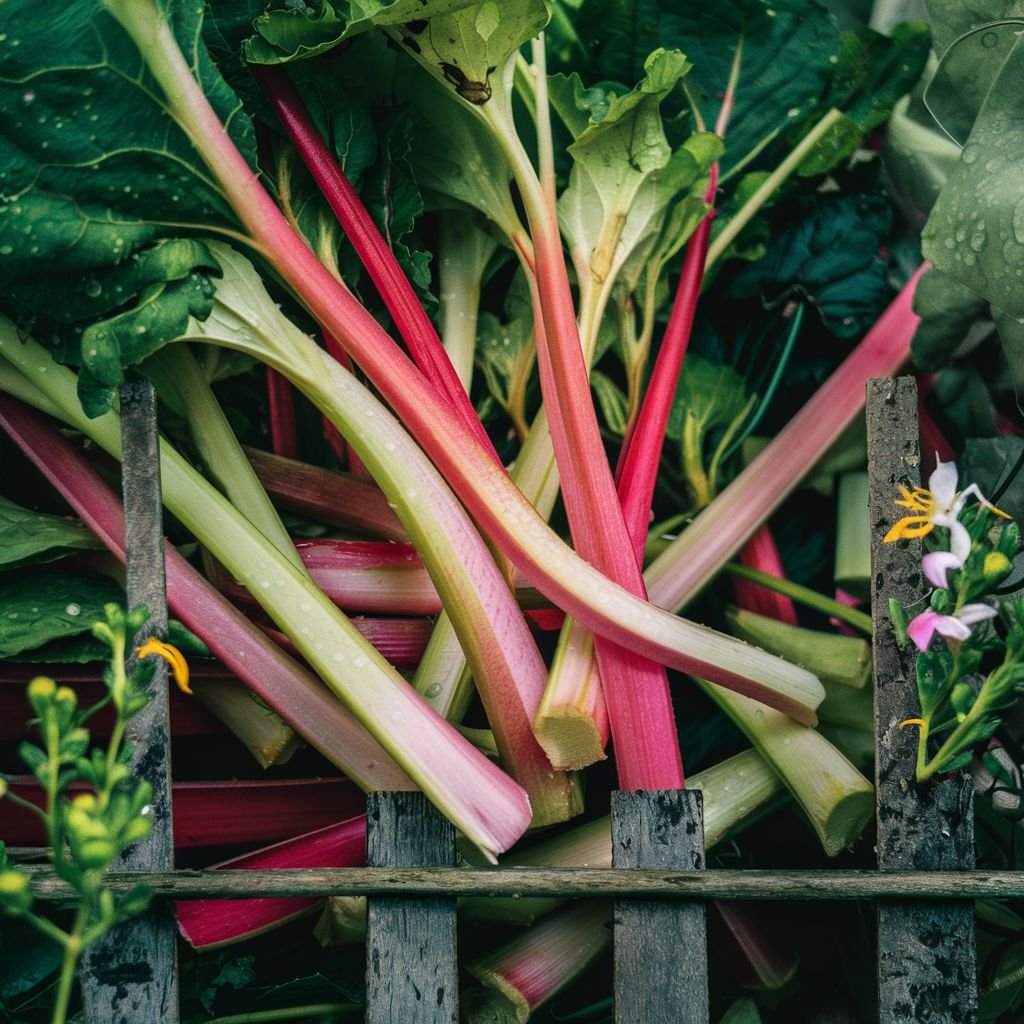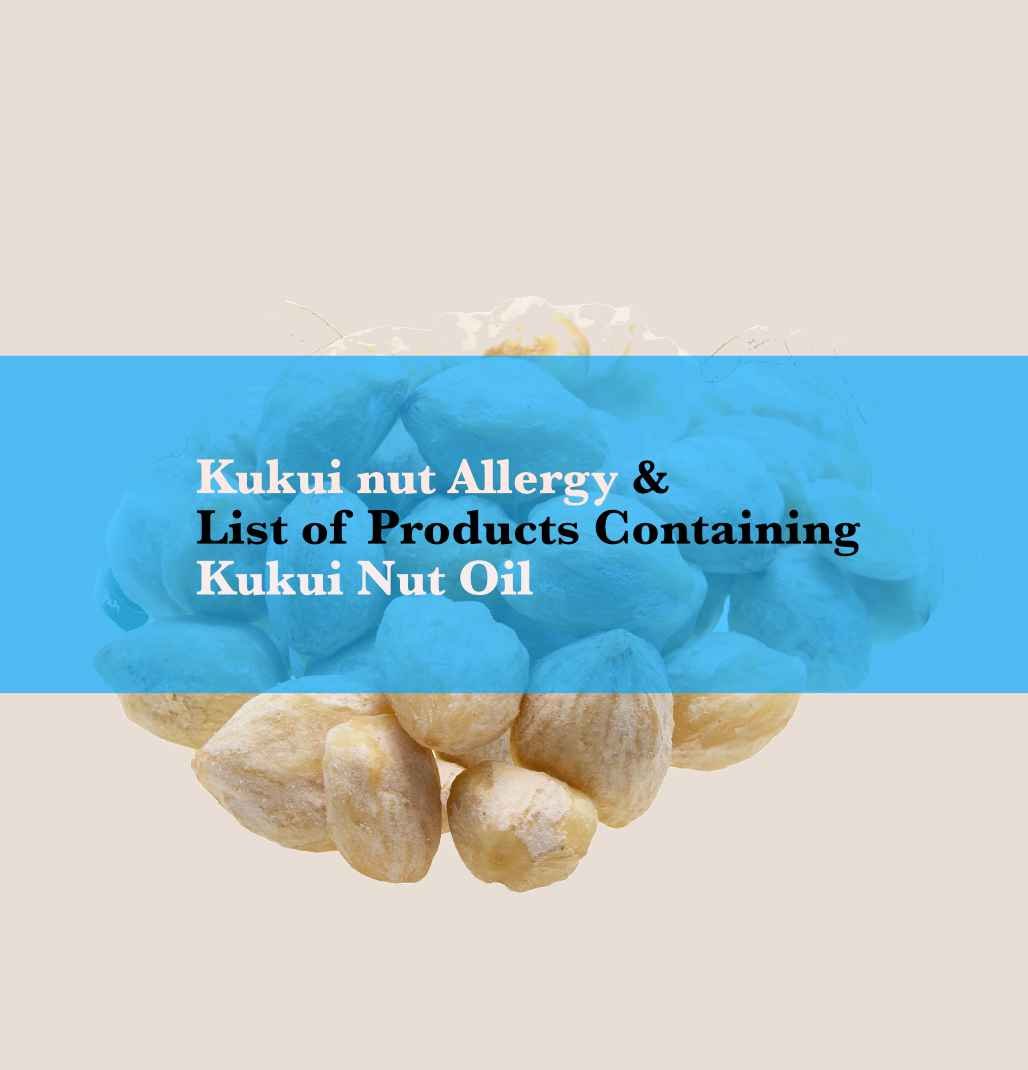Rhubarb: a plant that conjures images of delectable pies and desserts, especially popular in the spring and early summer. Known for its tart flavor, rhubarb has carved out a niche in culinary arts as a favorite ingredient for chefs and home cooks alike. But beyond its culinary uses, rhubarb holds a lesser-known aspect that could have significant implications for some individuals—its potential as an allergen: rhubarb allergy. While food allergies are increasingly recognized and managed in our society, certain allergies, like those to rhubarb, remain under the radar, surprising those who might unknowingly experience them.

Food allergies, from the common to the rare, remind us of the intricate ways our bodies interact with the foods we consume. Though less common than allergies to nuts, dairy, or seafood, a rhubarb allergy is no less important for those affected by it. The symptoms can range from mild discomfort to severe reactions, making it crucial for individuals, especially those with known food sensitivities, to recognize and understand how to manage this particular allergy.
This article aims to shed light on rhubarb allergies—what they are, how they manifest, and the steps one can take to diagnose and manage them. Whether you’re a teen, adult, or professional navigating the complexities of food allergies or simply someone curious about this peculiar condition, our exploration will provide you with comprehensive insights into living with and managing a rhubarb allergy. From identifying the symptoms to practical advice on avoidance, our journey into the world of rhubarb allergies begins with an understanding of rhubarb itself and its place both in our diets and in the landscape of potential food allergens.
With the introduction set, we’re ready to delve deeper into rhubarb, its uses, and the nature of rhubarb allergies in the following sections. This approach ensures a smooth flow of information, making the article accessible and engaging for readers seeking to learn more about this uncommon allergy. Ready to continue?
What is Rhubarb?
Rhubarb is a plant that, while often mistaken for a fruit primary due its common use in desserts, is technically a vegetable. Its long, crimson stalks and large green leaves are distinctive, but it’s the stalks that are edible and prized for their unique, tart flavor. Originating in Asia over 2,000 years ago, rhubarb was initially cultivated for medicinal purposes before making its way into kitchens around the world. Today, it’s celebrated in a variety of culinary creations, from rhubarb pie and crumble to savory sauces and compotes that accompany meats.
Culinary Uses and Nutritional Benefits
Rhubarb’s versatility in cooking is matched by its nutritional profile. It is low in calories while being rich in dietary fiber, vitamin C, vitamin K, and minerals such as calcium and potassium. Ribarb can be a healthful addition to a balanced diet. Its tartness is often balanced with sugar or used in combination with sweeter fruits, like strawberries, to create deliciously tangy dishes.
However, it’s important to note that while rhubarb stalks are edible, rhubarb leaves are toxic and should never be consumed. The leaves contain high levels of an irritant named oxalic acid, as well as other compounds that can cause serious health issues if ingested.
Identifying Rhubarb Allergy
Understanding rhubarb and how it’s used sets the stage for recognizing rhubarb allergy. Food allergies occur when the body’s immune system mistakenly recognizes and identifies a harmless food protein as a threat, launching a defense that can lead to various symptoms.
Symptoms of Rhubarb Allergy
The symptoms of a rhubarb allergy can be similar to those of other food allergies, including:
- Itching or tingling in or around the mouth
- Hives or rash on the skin
- Gastrointestinal discomfort, such as vomiting, diarrhea, or nausea.
- Respiratory issues, including wheezing or difficulty breathing in more severe cases
- Anaphylaxis is a severe, potentially life-threatening (in many cases) allergic reaction that requires immediate medical attention
Distinguishing between an allergic reaction and the toxicity of rhubarb leaves is crucial. If symptoms arise after consuming rhubarb stalks, especially if you have a history of food allergies, an allergy may be the culprit.
The Toxicity of Rhubarb Leaves
While delving into the realm of rhubarb allergies, it’s paramount to address a closely related yet distinctly different concern: the toxicity of rhubarb leaves. This aspect is crucial for understanding the overall safety and health implications associated with rhubarb consumption, distinguishing between allergic reactions and potential poisoning.
Why Are Rhubarb Leaves Toxic?

Rhubarb leaves contain high levels of the irritant, oxalic acid, an organic compound which is present in many plants but in particularly harmful amounts in rhubarb leaves. Oxalic acid, when consumed can bind with calcium in the body to form crystals, potentially causing kidney stones or other kidney issues in significant amounts. Additionally, rhubarb leaves contain anthraquinone glycosides, another compound that can contribute to their toxic effects.
Symptoms of Rhubarb Leaf Poisoning
The symptoms of rhubarb leaf poisoning differ from those of a rhubarb allergy and can include:
- Stomach pain and cramping
- Nausea and vomiting
- Diarrhea
- Weakness
- Difficulty breathing
- Burning sensation in the mouth and throat
Ingestion of large amounts of rhubarb leaves can lead to convulsions, kidney failure, or even death, although such extreme outcomes are rare. The amount of oxalic acid and other toxins can vary based on several factors, including the plant’s age and growing conditions.
Preventing Rhubarb Leaf Poisoning
Preventing rhubarb leaf poisoning is straightforward: avoid consuming rhubarb leaves. Always remove and discard the leaves before cooking with or consuming rhubarb stalks. Educating others, especially children who might be curious about plants, about the dangers of rhubarb leaves is also essential for preventing accidental ingestion.
Differentiating Between Allergic Reactions and Toxicity
Understanding the distinction between an allergic reaction to rhubarb and the symptoms of leaf toxicity is crucial for proper response and treatment. If symptoms arise after consuming rhubarb stalks, an allergy may be present. However, if symptoms develop after accidental ingestion of rhubarb leaves, it’s a matter of toxicity, requiring different medical attention.
This section aims to clearly outline the risks associated with rhubarb leaves, emphasizing the importance of distinguishing between the leaves’ toxicity and allergic reactions to the edible stalks. With this comprehensive understanding, we can proceed safely, fully aware of both rhubarb’s benefits and potential dangers. Let me know when you’re ready to continue.
Causes and Risk Factors of Rhubarb Allergy
To effectively manage and prevent rhubarb allergies, it’s essential to understand the underlying causes and who may be at increased risk. Like other food allergies, rhubarb allergies result from the immune system’s overreaction to substances that are typically harmless to most people. However, specific factors can predispose individuals to develop these reactions.
Genetic Predisposition
As with many types of allergies, genetics is a significant risk factor for developing a rhubarb allergy. If your family has a history of allergies—food allergies, hay fever, asthma, or eczema—you may be more likely to develop a rhubarb allergy. This genetic link suggests that certain individuals are born with a higher tendency for their immune system to overreact to specific allergens.
Environmental Exposure
The environment plays a crucial role in the development of allergies. Regular exposure to rhubarb, whether through diet or handling, can increase the likelihood of becoming sensitized to it. Sensitization occurs when the immune system becomes overly familiar with a protein, mistaking it for a harmful substance and triggering an allergic reaction upon subsequent exposures.
Age at First Exposure
The age at which someone is first exposed to rhubarb can influence the risk of developing an allergy. Early exposure to potential allergens, under certain conditions, can sometimes lead to a higher chance of sensitization. However, the relationship between exposure timing and allergy development is complex and can vary from one individual to another.
Cross-Reactivity with Other Allergens
Individuals with allergies to certain substances may experience cross-reactivity, where proteins in different substances are similar enough that the immune system reacts to both. For example, if you’re allergic to certain pollens, you might also react to rhubarb due to similarities in the allergenic proteins.
Identifying High-Risk Groups
Considering these factors, individuals with a family history of allergies, those who are frequently exposed to rhubarb, and people with existing allergies, especially to related substances, may be at a higher risk for developing a rhubarb allergy. Understanding these risk factors can help in early identification and management of potential allergic reactions.
Diagnosis and Testing for Rhubarb Allergy

When suspicions of a rhubarb allergy arise, obtaining a precise diagnosis becomes the cornerstone of effective management. Diagnosing food allergies, including those to rhubarb, involves a comprehensive approach that combines clinical evaluation with specific testing methods. This process is pivotal in distinguishing rhubarb allergies from other types of food sensitivities or unrelated conditions.
Clinical Evaluation
When it comes to rhubarb allergy, the diagnostic journey of evaluation begins with a thorough clinical evaluation, where a healthcare provider gathers detailed information about the individual’s medical history and the symptoms experienced. Key points of discussion include:
- The timing and pattern of symptoms relative to rhubarb consumption.
- Any family history of allergies or autoimmune diseases.
- Previous allergic reactions and their management.
- Dietary habits and potential changes that coincide with symptom onset.
This initial assessment aims to identify any clear links between rhubarb exposure and allergic reactions, setting the stage for further testing if necessary.
Skin Prick Test (SPT)
One of the most commonly employed tests for diagnosing food allergies is the Skin Prick Test (SPT). During an SPT, a small amount of the suspected allergen, in this case, rhubarb extract, is placed on the skin, usually on the forearm. The skin is then gently pricked through the drop with a sterile lancet, allowing the allergen to enter just below the surface. If the individual is allergic to the substance, a raised, red bump (resembling a mosquito bite) will typically appear within 15 to 20 minutes.
Specific IgE Blood Test
Another diagnostic tool is the Specific IgE Blood Test, which measures the level of IgE antibodies to specific allergens in the blood. This test can help confirm the immune system’s sensitivity to rhubarb proteins for individuals with a suspected rhubarb allergy. Elevated IgE levels suggest an allergic response to the tested allergen.
Oral Food Challenge
An Oral Food Challenge (OFC) might be recommended if the diagnosis remains uncertain. Considered the gold standard for diagnosing food allergies, OFCs involve consuming gradually increasing amounts of the suspected allergen under medical supervision. Due to the risk of severe allergic reactions, this test is conducted in a controlled setting with emergency equipment and medications on hand.
The Importance of Professional Diagnosis
A professional diagnosis is crucial for confirming the presence of a rhubarb allergy and guiding the management and treatment plan. Misdiagnosis can lead to unnecessary dietary restrictions or, conversely, exposure to harmful allergens. Therefore, individuals experiencing symptoms suggestive of a rhubarb allergy should consult with an allergist or a healthcare provider experienced in diagnosing and treating allergies.
Management and Treatment of Rhubarb Allergy
The primary goal for individuals diagnosed with a rhubarb allergy is to effectively manage the condition to minimize symptoms and avoid potential health risks. While there is no cure for food allergies, including those to rhubarb, several strategies can help manage the allergy and maintain a high quality of life.
Avoidance: The First Line of Defense
The most effective way to manage a rhubarb allergy is to avoid consuming rhubarb and products containing rhubarb. This involves:
- Reading Labels Carefully: Always check food labels for rhubarb and its derivatives. Be mindful of products that may not explicitly list rhubarb but could still contain it, especially in processed foods, desserts, and sauces.
- Communicating Dietary Restrictions: When eating out or attending social events, communicate your allergy to chefs, servers, or hosts to ensure that your meals are free from rhubarb.
- Preparing Food at Home: Cooking at home allows for better control over ingredients and reduces the risk of accidental exposure to rhubarb.
Managing Accidental Exposure
Despite best efforts to avoid rhubarb, accidental exposures can happen. Knowing how to manage such situations is crucial:
- Mild Reactions: For mild symptoms, such as oral itching or a mild rash, over-the-counter antihistamines can provide relief. Topical creams may also alleviate skin irritation.
- Severe Reactions: In the case of severe allergic reactions, such as anaphylaxis, it is vital to use an epinephrine auto-injector if prescribed and seek emergency medical attention immediately.
Education and Awareness
- Self-Education: Stay informed about rhubarb allergy and current management strategies. Knowledge about your condition empowers you to make informed decisions about your health.
- Educating Others: Raise awareness among friends, family, and colleagues about your allergy to ensure they understand the importance of avoiding cross-contamination and accidental exposure.
Regular Medical Follow-Up
Regular follow-ups with an allergist or healthcare provider are essential for monitoring your allergy over time. These appointments provide an opportunity to review and adjust your management plan as needed, discuss any new treatments or research, and address any concerns or questions you may have.
The Role of Emergency Preparedness
Individuals with a rhubarb allergy should always be prepared for an unexpected allergic reaction. This includes carrying an epinephrine auto-injector (if prescribed) at all times and wearing medical identification jewelry that lists the allergy. Having an action plan in place and ensuring that those around you are aware of how to help in an emergency can make a significant difference in the outcome of an allergic reaction.
Living with Rhubarb Allergy: Day-to-Day Tips and Strategies
Adjusting to life with a rhubarb allergy involves adopting certain precautions and modifications to daily routines. These changes can help mitigate the risks of exposure and ensure safety, allowing those affected to enjoy a broad range of activities without constant concern. Here are practical tips and strategies for navigating day-to-day life with a rhubarb allergy.
Kitchen and Cooking Adjustments
- Ingredient Substitutions: Discover alternative ingredients, such as green apples or berries, that can replicate rhubarb’s tartness in recipes, ensuring you don’t miss out on your favorite dishes.
- Cross-Contamination Awareness: Be vigilant about cross-contamination in the kitchen. Use separate utensils and cutting boards for allergen-free cooking, and thoroughly clean all surfaces and tools after use.
Dining Out Safely
- Restaurant Research: Before dining out, research restaurants to ensure they can accommodate your allergy. Don’t hesitate to call ahead and discuss your dietary needs.
- Clear Communication: When ordering, clearly communicate your allergy to the server and, if possible, the chef. Ask about ingredients and preparation methods to assess the risk of cross-contamination.
Social and Travel Precautions
- Informing Hosts: If attending a social event, inform the host of your allergy well in advance. Offer to bring a dish you know is safe for you to eat.
- Travel Preparedness: Bring snacks and meals you know are safe when traveling. Research local cuisine and common dishes to identify potential risks and safe options.
Education and Advocacy
- Self-Advocacy: Be your own advocate when it comes to your allergy. Educate yourself on rhubarb and its potential hidden sources so you can make informed decisions.
- Raising Awareness: Use opportunities to educate others about food allergies, including rhubarb allergy. Awareness can lead to greater understanding and support from friends, family, and the community.
Support and Community
- Finding Support: Connect with others who have food allergies, through online forums, support groups, or local community groups. Sharing experiences and tips can provide valuable support and camaraderie.
- Mental Health: Recognize that living with a food allergy can be stressful. Seek support from mental health professionals if you find that your allergy is impacting your emotional well-being.
Conclusion – Rhubarb Allergy
Living with a rhubarb allergy doesn’t have to limit your enjoyment of food or your participation in social activities. You can navigate most situations safely and confidently with careful planning and communication. Embracing a proactive and positive approach to managing your allergy can empower you to live a full and active life.
Navigating life with a rhubarb allergy requires awareness, preparation, and a willingness to advocate for your health needs. By implementing these day-to-day tips and strategies, individuals with rhubarb allergies can manage their condition effectively and continue to enjoy a rich and varied lifestyle.



